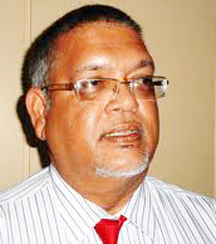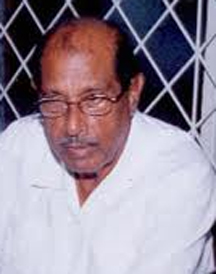The Guyana Water Inc (GWI) yesterday tried to make a convincing case to the Public Utilities Commission (PUC) for approval of a tariff proposal that it expects would help it bring its revenue levels within range of meeting its annual $7B operations cost by 2016.
But GWI’s Tariff Harmonisation Proposal was met with much skepticism at the public hearing organised by the PUC at Hotel Tower, prompting GWI Chairman Ramesh Dookhoo to emphasise the need for the utility company to become viable as he assured members of the Commission and all stakeholders present that its plan would make it possible.
“It is extremely crucial that these tariffs be implemented,” said Dookhoo, who noted the cynical eye with which the proposal was being viewed.
The last time a revised tariff system was implemented by GWI was in 2005.
GWI’s Chief Executive Officer Shaik Baksh explained that the company currently operates using tariffs approved by two defunct agencies—the Guyana Water Authority and the Georgetown Sewerage and Water Commissioners—which were eventually merged to form GWI. Baksh stated that the absence of a common tariff structure continues to create a host of issues, including failing to provide an adequate revenue base on which GWI can cover its operational and other costs. He also said the current tariff structure does not meet the social equity requirements, does not encourage the economic use of water, and does not allow for prompt reaction to external changes that affect the cost of water production such as power cost.

With its proposal, GWI is requesting the PUC’s approval to establish a definitive methodology for categorising customers; to differentiate between those who receive treated water and untreated water; to ensure the billing of unmetered customers at a rate that is closer to their average consumption; to ensure reasonable discrimination between domestic and non-domestic rates; and to ensure reasonable discrimination between customers in the hinterland (small towns) and the more established communities.
In addition, the company is seeking approval to implement proposed rates for the various Tariff Bands for the supply of water, the rates for the various Tariff Bands for Sewerage Services as well as approval for the introduction of a security deposit for new and delinquent subscribers.
In an attempt to justify the proposals, GWI’s Financial Director Jaigopaul Ram noted that with the present system the company incurred a cost of over $7 billion, while only generating about $3.9 billion in revenue in 2012.
He also pointed out that the GWI is currently the largest customer of the Guyana Power and Light Company (GPL), and incurs tremendous expenses for this service to be provided. Also, he said that many customers do not value the company’s service, which leads to the wanton wastage of water.
At the same time, Ram said, works to expand the provision of the water service and for the improvement of services to a wider cross-section of society have led to increased costs, and especially for energy, which is already extremely high. Baksh, a former Minister of Housing and Water, pointed out that the provision of treated water has increased tremendously over the years at the cost of hundreds of millions of dollars. He said that if the system is not changed, the company will continue to incur commercial and other losses.
Ram said that if the tariffs were consolidated, the company would see its revenue increase from $3.9 billion to $5.6 billion, while maintaining an expenditure of around $7 billion for 2013. Furthermore, he said that by 2014, revenues would rise to approximately $6 billion, with the operational cost at around $7.4 billion. By 2015, the company expects that revenue would rise to $6.103 billion, while operational costs would be $7.163 billion. By 2016, the company expects that revenue levels would increase to $6.73 billion, with operational costs at G$7.7 billion.
The increases in revenue, Ram said, would be facilitated by the cash recovery systems that would be implemented. He said that in 2012, GWI only collected around 66% of the revenue owed to it. He said that by the end of 2013, if the company’s proposal is approved, it can see this number jump substantially to 91%, reaching 98% by 2014, and peaking at 100% in 2015.
Metering


Baksh told the hearing that the proposed harmonisation would aim to do a variety of things, including metering all customers who can be metered, and where this is not possible, the implementation of a rate which is linked to the average consumption to determine the tariff regime. To this end, the company intends to intensify its operations to fit as many residences and commercial entities with meters where possible. Over the next four years, he said, the company plans to install about 110,000 new meters, 22,000 of which will be fitted by the end of this year.
GWI has already sourced the meters to be installed, he added, while noting that 30,000 meters have been procured.
PUC Chairman Justice Prem Persaud seemed less than impressed with the projections. He pointed out that for such a project to be properly executed, it would require a database in which the information on the company’s existing customers is housed. Though Baksh tried to assure that GWI’s existing database, though not perfect, is capable of facilitating this process, Persaud noted that GWI’s system is known for being a “mess.”
Acknowledging the database’s shortcomings, Baksh stated that the existing system is slated for a transition, with a new system being built utilising information from the older one. He said that GWI has been assured that this process would be completed in 50 to 100 days, once approval for the tariff consolidation is given by the PUC.
“I doubt the system will be up by the time frame given,” Persaud, however, responded.
Persaud also asked how the company would be able to monitor meters it is proposing to install, considering its longstanding problem of never having an adequate number of meter readers.
Baksh assured that this problem has been remedied. He said that the company now has 25 meter readers, who are responsible for reading all installed meters in each of the various divisions around the country.
His answer bemused many attendees, including Persaud, who asked the CEO if the number of meter readers was sufficient.
Baksh maintained that it was, explaining that readings are done every three months, and that each of the 25 readers has a quota of 1,000 meters to read per month, which works out to 25,000 meters per month, per meter reader. This, he said, allows them to cover the 75,000 installed meters in the various divisions.
But Rashnie Cornelius, a housewife of Better Hope, East Coast Demerara, told the meeting that for the past three years, a GWI meter reader has never visited her home, though she has a water meter. Cornelius said that though she is home most days, her meter has never been read, though GWI bills come without fail every quarter. She also mentioned that in one instance, she was overcharged and the matter was resolved only after she went into the company to query her bill.
Cornelius said too that the quality of water she sometimes received was “stink” and “unusable,” which left her no choice but to purchase water for bathing and washing.
Persaud said that if the numbers given by Baksh were accurate, then GWI was just at capacity and should probably consider increasing and maintaining the number of meter readers it employs.
Quality control
Shailendra Rai, head of the Legal Metrology and Standards Compliance Department of the Guyana National Bureau of Standards (GNBS) said his concern lay with the quality of meters being provided.
He explained that the GNBS engaged GWI to verify the quality of the meters but was told that the meters had already been tested. Rai said that the GNBS did not have a problem as long as the body which tested the instruments was independent and responsible. He said that the GNBS, however, requested copies of the “quality assurance certificates” attesting to the quality of the meters from GWI, but these were never received.
Dookhoo seemed to suggest that the GNBS may not be competent to run quality tests on the meters, when he asked if the labs and equipment used by GNBS were accredited.
Baksh defended the quality of the meters, saying they were Amico Water Meters and were among the best in the world.
However, Rai maintained that it remains the purview of the GNBS to ensure that all such equipment is quality assured, since Guyanese would be paying for the service and would need to receive quality for their money. He said that though the GNBS’ labs may not be accredited, its personnel were qualified and therefore competent to carry out testing of the meters.
Rai also raised concerns about periodic checks and maintenance for instruments as well as prevention against tampering. He noted that if any of the meters fail to meet the GNBS’s standards, it amounts to a violation of existing regulations, and may attract a fine. He did, however, note that the Act which addresses the issue in question is very old, and the fines which are payable are very small. He said that the GNBS is currently working to remedy this problem.
Under its proposal, GWI also plans measures to penalise customers who intentionally or unintentionally damage its infrastructure or waste water. The company stated that such actions will function as a deterrent, while allowing it to charge a fee which would assist in meeting its operational costs. The fee for water wastage in this instance will only apply to non-metered users, since those with meters will have the amount of water flow used recorded.
On this matter, Persaud asked if any plans are in the works to deal with large buildings which seem to take a toll on the sewerage system. He said that there have been complaints by persons who say that the construction of these buildings is looked into by GWI, since its offices hold the blueprints to the country’s sewerage and water system.
Additional concerns were raised by PUC Complaints Manager Raymon Cummings, who sought to find out how GWI would attribute blame and a charge in cases where it is not clear who may have tampered with or broken a pipe or a meter.
Cummings was, however, assured by the company that each case would be examined on its own merits and dealt with as such. This system was also questioned by members of the PUC, who sought to find out what method would be used to quantify the amount of water used and convert that amount into a charge.





